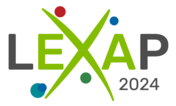Speaker
Description
The neutron-antineutron oscillation violates baryon number conservation and is of great importance in the context of testing Grand Unified Theories and understanding the origin of the baryon asymmetry in the universe [1].
Currently, the oscillation time is constrained to be $> 0.86 \times 10^8$ s for free neutrons, and $> 2.7\times 10^8$ s for bound neutrons [2,3]. In view of experiments planned in future facilities aimed at improving the limit with free
neutrons, recent proposals have been made that would substantially improve the sensitivity of the experiment with accurate understanding of the nuclear potentials experienced by low-energy antineutrons [4,5].
In this context, there is a renewed interest in the antinucleon-nucleus interaction. The data currently available are mainly from antiprotonic atom spectroscopy and antinucleon-nucleus scattering/annihilation cross-section measurements. The optical potential model developed well reproduces available experimental data of antiprotonic atom and scattering data. However, it has been pointed out that it still lacks full experimental verification [6].
In this presentation, the above topics are reviewed, and antiproton experiments that can potentially be conducted in this
context will be discussed.
[1] D.G. Phillips II et al., Phys. Rep. 612, 1 (2016).
[2] M. Baldo-Ceolin et al., Z. Phys. C 63, 409 (1994).
[3] K. Abe et al. (Super-Kamiokande), Phys. Rev. D 91, 072006 (2015).
[4] K. V. Protasovet al. Phys. Rev. D 102, 075025 (2020).
[5] V. Gudkov et al., Phys. Lett. B 808, 135636 (2020).
[6] E. Friedman, Hyperfine Interact. 234, 77 (2015).

